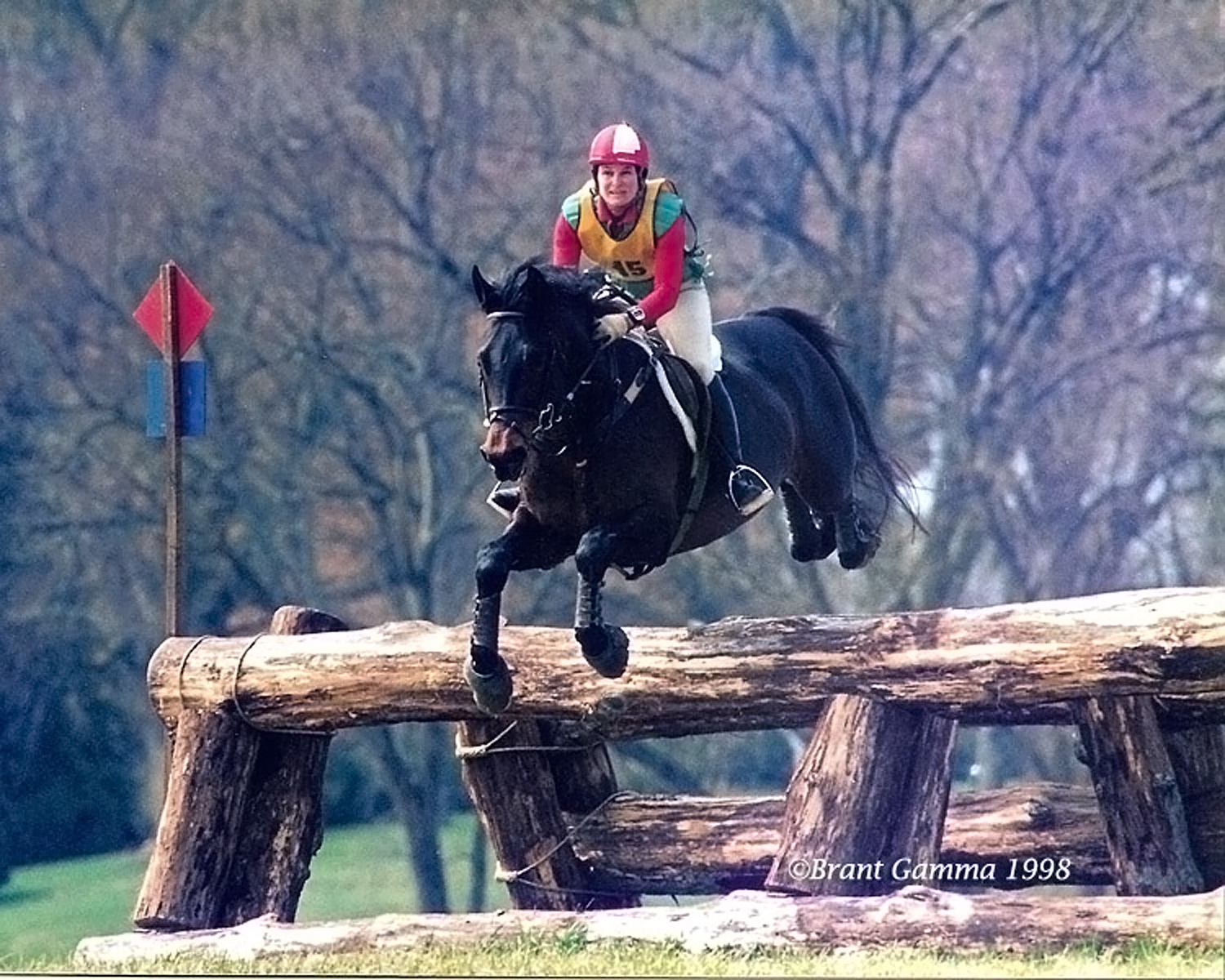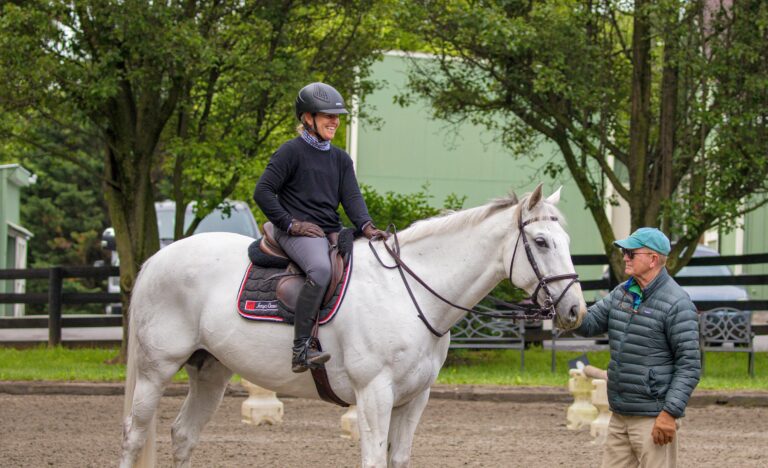Q: To what do you attribute your success as a rider, trainer and a leader in this industry?
CK: I’ve learned over the course of my career to pick and choose my battles. I try not to be confrontational. Maybe it’s working with a group of people and we don’t agree. Or working with a horse. It’s trying to be thoughtful. I ask myself, “What is the smoothest path forward while still being intent on gaining my ground?”
Q: How do you define leadership?
CK: Leadership is often best conducted by example. I
go through my day trying to do the right thing. I hear a lot from people that they know that I am going to try, to the best of my ability, to do best for everyone. I don’t have an agenda.
Q: At the U.S. Eventing Association, you are known as “the champion for the little guy.” Why does this matter to you?
CK: I still ride at the upper level, but I do a fair amount of teaching and training of lower-level riders. So I have a foot in both camps.
I feel a strong connection to our grassroots people. Upper- level riders are supported in so many other ways. International riders have a place at the table. But the little guys tend to get the leftovers. These are the people who are liaisons to the sponsorships; they provide the livelihood for a lot of these upper-level professionals. I think it is very important that we be inclusive and listen to them.
Q: Lower-level riders represent 80 percent of the USEA membership. What are their issues?
CK: We are at a crossroads. For the upper-level and international riders, eventing is headed in a different direction; we’re seeing more upper-level courses designed with more technical questions. Juxtapose this trend to the lower levels—they just want to run and jump. They don’t want bigger, faster, trickier—those trends worry them.

The bigger purses and increased prize money have become very important to our upper-level riders. Express eventing, arena eventing, showcase eventing, whatever you want to call it—it raises the profile of eventing for the public. But it is a very different animal than what the lower-level riders hold dear.
And somewhere along the way, our sport became responsible for providing a livelihood and sustaining the business aspirations of many professionals. The industry has morphed into a higher-dollar enterprise and now many amateurs, lower-level riders and smaller-event organizers can no longer afford to participate. And that’s a shame.
Q: As the new president of the USEA, how will you address this divide?
CK: We have stars in these sports—gifted riders and trainers. But they are not always good at seeing the bigger picture or understanding the whole population. Nor are they always good communicators or listeners.
When you start examining things from a different perspective, it is sometimes a much different view. So you have to listen and knit your positions into other people’s ideas. I hope I can create an atmosphere of inclusiveness. It’s difficult to keep everyone happy. I learned that right off the bat in my presidency!
Q: What is your strongest trait?
CK: I have learned to go with my gut, to trust my instincts. Dealing with some people—or horses—just gives you a bit of a bad feeling. I could be in conversation with a person who is saying all the right things, but I just don’t have a feeling that they are entirely ethical or honest or that they have everyone’s best interest at heart. I’ve learned to trust that.
Q: What does a special horse teach us?
CK: They make you believe in yourself because they believe in you. That was true for me with Hideaway’s Erin Go Bragh; especially with that horse because at the start we did not have high expectations. Each time we asked him harder questions he said, “If you think I can do that, I guess I can.”

Because of his small size, he was often the underdog. He was very intelligent and handsome and he oozed charisma. He gave me such confidence as a rider. I was tasked with managing his career responsibly and not overfacing him, and he rewarded me by climbing the ladder. We ended up competing with the big boys.
Q: Who do you admire outside of riding and why?
CK: My mom. She raised a big family and it was not easy. She was one of the best people I’ve known. I’ve always thought that if I could grow up like her, I’d be just fine.
Q: In 1997, you led the campaign to have the FEI change the rule regarding minimum weight requirements in eventing. Why was that important to you?
CK: When I was in my early 20s, there was an international rule in place that all riders had to weigh in at at least 165 pounds. I was riding Dr. O’Dea’s horse at the time and I weighed about 115 pounds. I had to carry 50 pounds of lead—or I should say my horse did. It was absolutely a handicap.
Most trainers didn’t understand it, but the women did. A lot of the men saw nothing wrong with it because they saw it as an equalizer, a handicapping system. But since many of the lighter women were riding smaller horses that we fit, the weight rule made it much harder for the smaller horses to compete.
I made this my crusade because the rule felt outdated and discriminatory. I felt that eliminating the rule would be an improvement for our sport. And I was joined by many like-minded people; their support was really important to me.
Q: In this industry, what counts?
CK: Hard work and dedication and honesty and a sense of responsibility count. I am harder on my young people than perhaps I should be. But it worries me when I see some of that being eroded in our sport.
Q: What one thing about yourself would you change?
CK: Sometimes I wish I could be more tolerant. Lazy people make me nuts. I react negatively to people who I don’t feel are being honest. I try not to be inflammatory but if I think someone is way off base, I’ll react. It’s gotten me into trouble in relationships and in business. I need to not always say what I think.
I think the horse business is a bit of a service industry and every now and then people don’t want to hear what you have to say. I’ve had to ask myself, “Can I look in the mirror if I change my ethics for this person?” So I’ve tended to put it out there if I think it’s the right and moral thing to do. I’ve lost customers, but there have always been other programs that better suited them. Lowering my standards is a slippery slope that I’ve tried to avoid.
Also, I don’t get enough sleep! And I am not a terribly gifted cook.
Q: What have you learned from riding that has helped you in other areas of your life?
CK: In the sport of eventing you have to be a bit brave. You have to be confident in yourself and in your training, you have to convey that confidence to your horse. It’s a zen place. In our sport you learn a kind of calm bravery.
When I challenged the FEI weight rule, I was up against some of the biggest names in the sport. It was the first time I ever had to face an unfriendly audience. I was sweating bullets, I was afraid that I would be made to feel foolish or worse yet, dismissible.
But I told myself that being brave in front of a hostile audience is just like going out on a big course. And I learned that I would survive it. I’ve had a few crusades since then that I’ve taken on that have stirred up public opinion. But I’ve survived the bumps and bruises.
Q: If you could go back in time, what would you tell your 20-year-old self about becoming successful as a person?
CK: I used to think when I was young that I had to hang with the “right crowd.” What I’ve learned is that when I trust my instincts, work hard and am honest, the “right crowd” has found me. Making an effort to be respected hasn’t always been the same as being popular.
Q: What has been your biggest failure and how did you bounce back?
CK: It is such a blow when you have a horse going along and they break down. I don’t know if it qualifies as a failure, but it feels that way. You are trying to take the best care of these horses, you’ve got a long view of where you are going with a horse and then it doesn’t go the way you envision.
It’s hard to get them to a certain point and then have your table kicked over. It has happened to me a couple of times—I now have a couple of high- quality pasture ornaments.
But I am pretty good at putting one foot in front of the other. I will have a private little cry, then I am very good at saying, “Now what can I do?” I focus on the prospect of bringing a new horse along again. You’ve got to have that kind of inner strength. You have to be able to handle defeat in so many ways; you’ve got to be resilient in this sport.
Q: What have you learned that you consider a life lesson?
CK: Don’t ever close your mind. You haven’t finished the journey yet. You are not done.
Carol Kozlowski grew up in Avon, New York, and by age 12 she was the only horse-crazy person in a nonhorsey family. She borrowed a neighbor’s pony to join her local Pony Club, and at the age of 18 she started working for Dr. Joseph O’Dea, a local International Equestrian Federation (FEI) vet who officiated at eventing competitions. Carol rode his Thoroughbred Frankie all the way to the Advanced level. Along the way, she trained with Olympians Karen O’Connor, Jessica Ransehousen and Anne Kursinski.
In 1987, Carol’s life changed when she got the ride on a 15.1-hand Connemara stallion. Hideaway’s Erin Go Bragh had been moving steadily up the ranks and his partnership with Carol became the stuff of legend. Following their win at the Ledyard Three-Day Event in 1992 and the 1995 AHSA Zone 2 Advanced Championships, the pair was featured in the video “The Little Horse That Could.” The popular and charismatic Erin Go Bragh was ultimately cast as a Breyer horse model.
Carol continued in her career, eventually bringing eight horses to the Advanced level. She has been long-listed for the Olympics and short-listed twice for the Pan American Games.
A successful competitor and coach for over 30 years, Carol has also been active in developing eventing. She has served on the U.S Equestrian Federation Eventing Technical Committee and on the U.S. Eventing Association Board of Directors. Last December, she was named USEA president. She lives with her husband, Randy, in western New York and works out of her farm Mothersfield.
This article originally appeared in the May 2017 issue of Practical Horseman.










